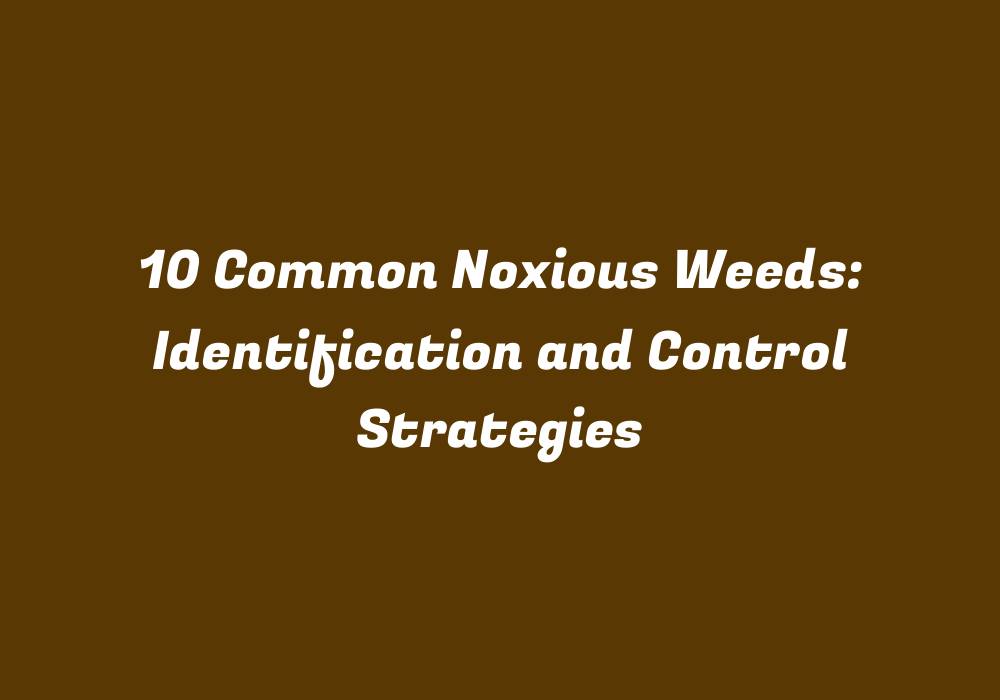Introduction to 10 Common Noxious Weeds
Invasive plants, also known as weeds or noxious weeds, can have significant negative impacts on the environment and human activities. They spread quickly and often out-compete native species for valuable resources like water and sunlight. This article aims to provide information on ten common invasive plant species along with identification techniques and control strategies to prevent their growth.
1. Kudzu
Identification: Kudzu, scientifically known as Pueraria montana, is a fast-growing, climbing perennial vine with heart-shaped leaves and small white flowers. It has large vines that can cover vast areas and spread rapidly through its extensive root system.
Control Strategies: Physical removal of the plant, cutting or mowing to limit growth, and herbicides are common control methods for kudzu management. However, it is essential to monitor and re-treat regularly as this invasive species can quickly grow back.
2. Purple Loosestrife
Identification: A perennial herbaceous plant that grows up to 6 feet tall, purple loosestrife (Lythrum salicaria) has spiked purple flowers and oval-shaped leaves. It is primarily found along waterways where it forms dense stands, negatively impacting native vegetation.
Control Strategies: Hand removal or cutting is effective in limiting its spread, as well as using chemical treatments targeted towards the plant’s roots. Additionally, introducing specific biological controls such as plant-eating insects or pathogens can help reduce the population of this invasive species.
3. Japanese Knotweed
Identification: Also known as Fallopia japonica, Japanese knotweed is a perennial plant characterized by its bamboo-like stems and heart-shaped leaves. It rapidly grows up to 10 feet tall and spreads through underground rhizomes.
Control Strategies: Herbicides specifically designed for woody plants are effective in controlling Japanese knotweed. Mechanical removal is also a viable option, but the plant must be properly disposed of to prevent regrowth. It’s important to address any potential new shoots as well.
4. Leafy Spurge
Identification: Euphorbia esula, commonly known as leafy spurge, is a perennial weed with large oval-shaped leaves and yellow flowers. This plant can grow up to 5 feet tall and has an underground root system called a rhizome that allows it to spread easily.
Control Strategies: Chemical control using herbicides is the most effective way of controlling leafy spurge. Mechanical removal by cutting or digging out its roots can also be implemented but may not be as successful due to its extensive root system.
5. Russian Olive
Identification: Scientifically named Elaeagnus angustifolia, the Russian olive is a deciduous shrub or small tree with silvery leaves, fragrant yellow flowers, and small fruits. It can grow up to 30 feet tall and quickly colonizes disturbed areas.
Control Strategies: Mechanical removal through cutting and root pulling is an effective way of controlling Russian olive. Herbicides may also be applied to its roots and trunk, but their effectiveness varies depending on the plant’s age and overall health. Biological control methods involving insects can also help in reducing this invasive species.
6. Mullein
Identification: Verbascum thapsus, commonly known as mullein, is an herbaceous plant with tall, hairy stalks and large, woolly leaves. Its yellow flowers grow on a central spike and bloom during summer months.
Control Strategies: Hand-pulling or digging up the entire plant is one method of control, but it may not prevent regrowth in the future. Herbicides can be applied to its leaves or roots, targeting the root system for more effective management.
7. Himalayan Balsam
Identification: Scientifically called Impatiens glandulifera, Himalayan balsam is an annual plant with bright pink flowers and heart-shaped leaves. It can grow up to 10 feet tall and spreads rapidly through its seed dispersal system.
Control Strategies: Manual removal of the entire plant can be successful, but it’s crucial to remove all parts to prevent regrowth. Herbicides may be applied to control this invasive species, focusing on targeting root systems and new sprouts for better results.
8. Scotch Thistle
Identification: Onopordum acanthium, commonly known as Scotch thistle, is a biennial plant that grows up to 5 feet tall and features large purple flowers with spiked edges on its leaves. It spreads through seeds dispersed by the wind.
Control Strategies: Manual removal of this invasive species can be done through hand-pulling or cutting. Herbicides may also be applied for better control, but it’s essential to target the entire plant, including its roots and new sprouts.
9. Field Bindweed
Identification: Convolvulus arvensis, commonly known as field bindweed, is an annual or perennial weed with white to pink flowers and heart-shaped leaves. It grows rapidly in disturbed areas and has a deep root system that makes control challenging.
Control Strategies: Manual removal of this invasive species can be done through hand-pulling, but it may not prevent regrowth due to its extensive root system. Herbicides are often necessary for effective control, targeting the root systems and any new sprouts that emerge.
10. Garlic Mustard
Identification: Alliaria petiolata, commonly known as garlic mustard, is a biennial weed with distinctive kidney-shaped leaves and white flowers. It grows rapidly in moist, shaded areas, outcompeting native vegetation for resources.
Control Strategies: Manual removal of the plant can be done through hand-pulling or digging, but it’s essential to remove all parts to prevent regrowth. Herbicides may also be applied to target its root systems and any new sprouts for more efficient control.
Conclusion
In conclusion, understanding the identification of common invasive plants and employing appropriate control strategies is crucial in preventing their rapid spread. A combination of physical removal and targeted herbicide application can help manage these noxious weeds, ensuring a more balanced and healthy environment for native species to thrive.
Resources
Invasive Species Information: Plants
University of Illinois Extension: Weed Management
Invasive Plants: A Growing Concern for Ontario’s Agri-Food Sector
